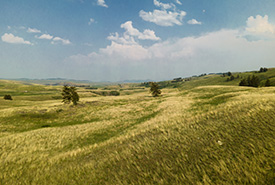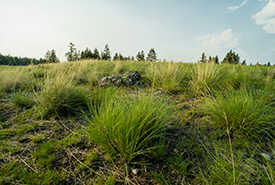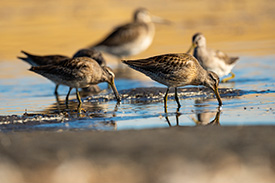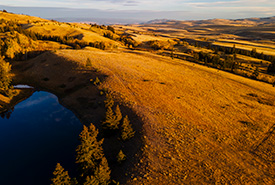Bunchgrass Hills Conservation Area
Due to the elevated wildfire risk across British Columbia, some of NCC’s conservation areas are currently closed to public access. Please check our Current Fire Closures page for more information.

Bunchgrass Hills. (Photo by Fernando Lessa)
From afar, the rolling hills and sweeping vistas of waving grasses in the Nicola Valley and north of Kamloops are stunning in their own right. But it’s hard to truly appreciate the abundance of life thriving among the grasses until you look up close.
It’s then that you’ll see the distinct species of grasses and the myriad of wildflowers, swaying in the wind and buzzing with insect life. Among the rolling hills, wetlands host numerous amphibians while the birds come and go on their seasonal migrations. Harder to spot are the burrowing animals, but the small tunnel entrances prove that they’re there.
Bunchgrass Hills Conservation Area is a vast expanse of native grasslands, forests and wetlands south of Kamloops within the traditional territories of the Secwepemc, Nlaka’pamux and Syilx Nations. At more than 6,100 hectares spread out in four separate areas, it marks one of the largest private grassland conservation projects in British Columbia.
Grasslands are at a high risk of fragmentation and development, which can be detrimental to the integrity of these ecosystems. Conserving an area of this size enhances connectivity in the valley and protects wildlife corridors for animals to roam unhindered. Plant communities will also benefit from a buffer from development disturbance and competitive non-native species.
NCC acknowledges the importance of working with the First Nations in whose territories these lands are situated. NCC will take time to understand the land’s Indigenous cultural values so that key cultural interests can be prioritized alongside ecological values in the ongoing stewardship of the conservation area.
Bunchgrass Hills adds to the Nature Conservancy of Canada’s (NCC’s) existing conservation lands south of Kamloops. Formerly part of the historic Stump Lake Ranch, the conservation area will continue to support sustainable cattle grazing while being managed for conservation. NCC has previously collaborated with conservation-minded ranchers in the area, conserving more than 10,000 hectares to date at Frolek Ranch, Warner Philip Conservation Area and Napier Lake Ranch Conservation Area.
Sea of grasses

Bunchgrass Hills is named after the many grass species that flourish here. (Photo by Fernando Lessa)
Named after the many varieties of bunchgrass that flourish here, Bunchgrass Hills is primarily open grassland habitat with pockets of dry forests and wetlands. It contains Bunchgrass and Interior Douglas-fir ecosystems, both of which are areas of conservation concern. The open landscape was previously maintained by a history of frequent, low-intensity wildfires, which burn back encroaching shrubs and trees and keep the grasslands open.
The dry Interior Douglas-fir forests cover one third of the Bunchgrass lands, and feature Rocky Mountain Douglas-fir, trembling aspen, and ponderosa pine.
Freshwater flows through the dry landscape, fed by the South Thompson, Nicola Lake and Lower Nicola River watersheds. More than 100 hectares of wetlands and small lakes are spread out throughout Bunchgrass Hills, with nearly 2,000 hectares of associated upland habitat.
Wildlife

The wetlands at Bunchgrass Hills attract many species of bird. (Photo by Steve Ogle)
In BC, grasslands represent less than one per cent of the provincial landbase, yet they support more than 30 per cent of its species at risk.
Bunchgrass Hills secures substantial, diverse and connected habitat for dozens of species iconic to BC’s interior. It is also mapped Critical Habitat for four federally listed species at risk: the endangered American badger, threatened Lewis’s woodpecker, the threatened Great Basin gophersnake, and the threatened Great Basin spadefoot toad. The availability of grasslands, open forests, wetlands and rocky areas at Bunchgrass Hills help support these at-risk species as they each require a diversity of habitats throughout their life cycles.
The grasslands at Bunchgrass Hills are also important breeding grounds for sharp-tailed grouse as five mating sites — or leks — are known to occur on the property.
The Nicola Valley plays a critical role in animal migration and movement routes. Much of the Valley falls within the Douglas Lake Plateau Important Bird Area, and is particularly notable for its abundance of wading bird species and species that gather in large groups during their life cycle. Waterfowl, in particular, use the wetland and upland habitat on Bunchgrass hills for feeding, breeding and nesting.
Bunchgrass Hills also provides important ungulate winter range for mule deer.
An urgent responsibility

Bunchgrass Hills in the fall. (Photo by Steve Ogle)
Grasslands play a vital role in maintaining the Canada’s biodiversity and improving climate resiliency.
Protecting grasslands in their natural state is an important natural climate solution for effectively mitigating the amount of carbon being released into the atmosphere. The grasses found in these landscapes have extensive root systems that can extend metres below ground, creating a considerable amount of carbon storage in the roots and soil.
Grassland carbon stocks have diminished substantially over the past decades because of the conversion and unsustainable management of grasslands. Conserving Bunchgrass Hills avoids grassland conversion to instead implement careful, conservation-focused land management, such as sustainable grazing, to protect and enhance the grasslands’ health.
Protecting large intact grasslands also contributes to provincial and national targets to protect 30 per cent of BC and Canada’s land by 2030.
Partners in conservation
NCC recognizes the generous contributions from its conservation partners that made this project possible. The Province of British Columbia provided funding through the Ministry of Water, Land and Resource Stewardship. The Government of Canada contributed funding through the Canada Nature Fund.
Additional supporters who funded this project include:
- Cathy and Rick Milne, in honour of Pat and John James and the Demmery family
- Sitka Foundation
- Teresa & Peter Leggat
- Collings Stevens Family Foundation
- Robert Foord in memory of Caroline Emily Fraser
- Drs. Margaret & Glen Carlson
- The Freya Fund
- Eric Grace
- Kingfisher Foundation
- other anonymous donors




